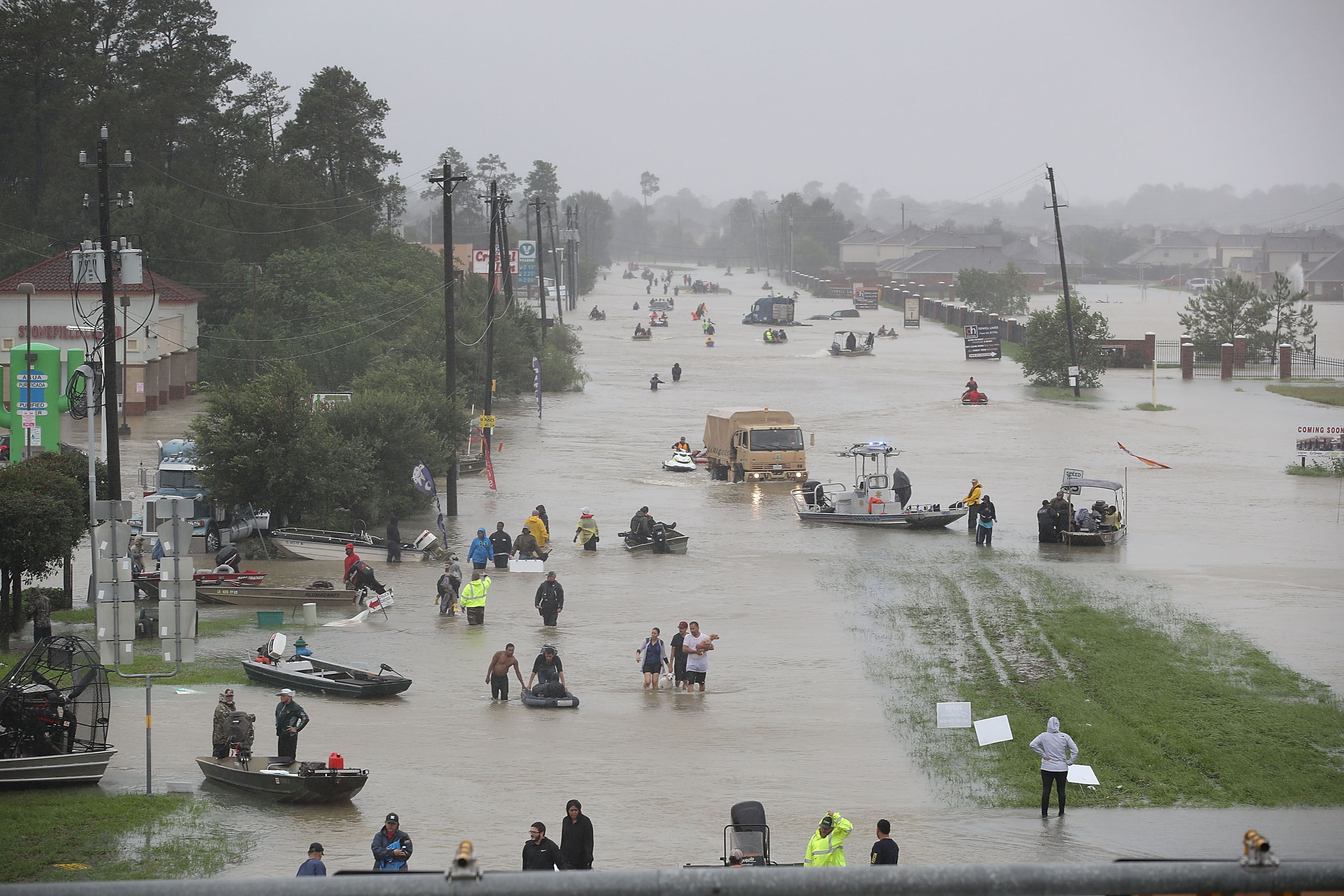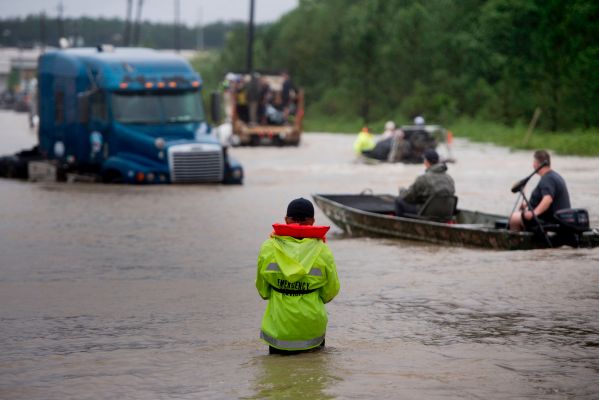As Tropical Storm Harvey made its second landfall near the border of Louisiana and Texas this week, New Orleans marked the 12-year anniversary of Hurricane Katrina.
In the intervening years since those storms, the nation has been continually pummeled by “historic” climatological events.
While the country has been taking this beating from Mother Nature, the conversation in statehouses, city halls and Washington has been bogged down in a discussion about climate change. What causes it, what to do about it, and whose fault it is that we’re here.
This argument between the left and the right is ultimately a distraction and offers political cover for people unwilling to tell the country about the hard and expensive choices it faces.
So here’s a modest proposal. Forget about climate change. For the immediate future, let’s accept that we’re already fucked, and discuss ways to prevent our cities from becoming glorified fish bowls so we can save populations most at risk from these weather events. Using tech can help provide the answer.
And for anyone curious about the extent of all of the historic disasters that’ve been unfolding in the past year alone, consider the following.
In August 2016, a storm flooded East Baton Rouge Parish, decimating the city and its surrounding towns, destroying 30,000 homes and killing 13 people.
Last June 26 people died in the worst flooding West Virginia had seen in 100 years (the state also was inundated with flooding this year, too); in the winter, Jonas broke records as the largest snowstorm ever to hit several cities, including New York, Baltimore, and Harrisburg, Pa. Fifty people died as a result of the blizzard, which affected around 102.8 million people in 26 states.
Add the multi-year drought that hit California from 2012-2016 (a once-in-a-1,200 year event by some accounts), and heatwaves across the Southwest, and even casual observers can get the sense that something is definitely happening here.
Since 2001, natural disasters have caused roughly $814 billion in damage, according to the NOAA’s National Centers for Environmental Information. For the 20 preceding years the total was $439.4 billion. (Cleanup from Harvey is expected to add another $190 billion to that total.)
During all of this, federal dollars that could be spent preparing cities for the next natural disaster have been tied up thanks to a debate about whether or not climate change is the culprit for what’s come before.
Administration officials and conservative lawmakers and think tanks have studiously avoided attributing Harvey’s severity to climate change or ridiculed reports that do. And lawmakers who control billions of dollars in the House and Senate have emerged as vocally opposed to approving any policy which grounds its logic in the notion of climate change.
The president has rolled back an order from the previous administration requiring infrastructure projects account for climate change and rising sea levels during the development process.

US President Donald Trump and First Lady Melania Trump depart the White House in Washington, DC, on August 29, 2017 for Texas to view the damage caused by Hurricane Harvey. NICHOLAS KAMM/AFP/Getty Images
“We are beyond the point [of addressing climate change] for the next twenty or thirty years,” said Brigadier General Gerald E. Galloway (ret.), a member of the advisory board for the Center for Climate and Security, and a Professor of Engineering at the School of Public Policy at the University of Maryland, told me. “The roller coaster is at the top and it’s going to come down at a pretty good rate. So you’d better start preparing to deal with this.”
For Galloway, that means mobilizing local and state government, and educating the population about the steps they can take to mitigate some of the risks from climate-related natural disasters (FEMA already recommends people plan on being self-sufficient for 72 hours).
Gen. Galloway also has a dim view of the role of the federal government — at least in the near term — thanks to the climate change debate. “I’m not going to expect an awful lot from these guys in Washington,” he said. “In terms of dealing with this issue of climate, they’re so paranoid about the use of that word that people step away from problems they need to address.”
Safer living by design
Luckily, states and cities — and even individual citizens — can take steps to plan for a future that includes more severe weather and more frequent natural disasters. And technology is playing a role in empowering the responses to making cities more resilient and citizens better prepared to deal with these catastrophes.
“When one of these events hits, everyone starts turning to infrastructure and asking ‘What do we do?'” Joseph Kane, a senior research associate at Brookings Institute’s Metropolitan Policy Program, told me.
His answer? “We are facing some extreme climate events and we need to actually upgrade and modernize our infrastructure systems that are in some cases over 100 years old,” Kane said.
Rit Aggarwala, co-head of Sidewalk Labs and the author of New York’s sustainability and resiliency plan, puts the types of ways governments address natural disasters and their impact into four buckets: predict, mitigate, rescue and rebuild.
In each of these different stages, new technology companies and services can play a role. Indeed, in New York, when Aggarwala was putting the new plan for sustainability and resiliency in place, technology played a critical role in the process.
Big cities, meet big data
“The set of floodplain maps that we had were really done between the 1930s and the 1950s were done with surveying techniques that had been accurate and state of the art then, but not accurate now,” said Aggarwala.
The city paid for new maps made using LIDAR technology and those maps provided the basis for the city’s predictions on how New York may flood if it were hit by a major storm. It was only a few years later when the city’s thesis was put to the test as Hurricane Sandy ripped through New York and New Jersey.
“It was using that data which made predictions for where Hurricane Sandy was going to flood New York really accurate,” Aggarwala said. “It allows you to do your evacuation planning with much better accuracy.”
Better mapping technologies can give urban planners a sense of where natural disasters will have the most impact, but predicting those disasters requires more precise information of events. Technology can help here, too.
“More and more forecasting is moving into the hands of the private sector… particularly in the agricultural sector,” Benjamin Preston, Program Director, Infrastructure, Resilience and Environmental Policy at the Rand Corporation, told me. “For private tech that’s an area where they’re really investing heavily to use and manage risk and maximize productivity.”
These data collection technologies have implications for more than just flooding. Data from companies like The Climate Corporation, The Weather Company, KatRisk, and Weather Risk Management Services, could help states like California deal with drought. “If we were able to get longer lead times in terms of severity of drought, duration of drought, and when it may potentially end,” that would be helpful in planning, Preston said.
Distributed energy and water management systems for all
If analysis and mapping can help with the prediction of events and partially mitigate their severity, distributed energy systems like micro-grids and renewable energy like solar and wind power can mitigate the potential for power loss if centralized electricity systems go down.
This has nothing to do with the emissions profile of these generating technologies. Instead, it’s about making power grids more flexible and less reliant on large centralized power plants and transmission networks that can fail in a powerful storm, earthquake, fire or flood.
Here, companies like Tesla, with its solar arrays and Powerwall, can offer technologies that could help, according to Aggarwala.
“Predicting your rainfall and taking your holding tanks and wetlands and draining them twelve hours before a storm arrives — there’s no way that would help in Houston today — but in a situation where you’re getting 12 inches of rain instead of 50 inches of rain,” it would make a difference, Aggarwala said.
Consumer tech to the rescue
Aggarawala also sees consumer technologies playing a role in relief efforts, acting in concert with federal, state, and local agencies. Social networks are already doing their part in the relief efforts for Harvey.
The “Cajun Navy,” a motley hodgepodge of citizen sailors from Louisiana who first mobilized on social media in response to last year’s flooding in Baton Rouge, were using Twitter and Facebook to aid in their rescue efforts of those affected by Harvey.
Here’s a little bit more background on the group of good samaritans who made their way to Texas to aid in recovery and relief efforts, courtesy of NOLA.com.
Facebook, Twitter, Instagram and Snap are all being used to tell stories of victims and post requests for aid — often over the protestations of law enforcement and other first responders — in what Preston called the first big hurricane to make landfall in the social media age.
“You’re seeing so many stories right now in social media saying ‘Yes, I’m okay.’ or ‘No, I’m not okay and I need to be rescued.’ This is giving you a taste of the role that [social media] can play just around communication in the emergency response side of things,” Preston said.
Hard problems and hardware solutions
Aggarwala also suggested that homeowners could give first responders access to home security and automation systems like Nest or Canary (with limits) to provide better data about who may need rescuing in a home or to remotely monitor a neighborhood in a crisis situation.
Other hardware technologies can also aid first responders and recovery efforts, according to Preston. He noted that several drone companies like: Early Warning Labs, Drone Adventures, PrecisionHawk, Textron Systems are all working on disaster relief and recovery efforts.
Critically, all of these technologies should have applications beyond just their potential to help in a time of crisis, according to Kane. “We need to do something about infrastructure nationally,” Kane says. “It’s not just extreme weather events, but the chronic stressors too… These systems are old and quite literally inundated.”

HOUSTON, TX – AUGUST 28: People walk down a flooded street as they evacuate their homes after the area was inundated with flooding from Hurricane Harvey on August 28, 2017 in Houston, Texas. Harvey, which made landfall north of Corpus Christi late Friday evening, is expected to dump upwards to 40 inches of rain in Texas over the next couple of days. (Photo by Joe Raedle/Getty Images)
Resiliency is the answer
That’s going to require thinking beyond the status quo “repair and replace” mentality which dominates the current conversation around infrastructure.
“We have built out an enormous network of transportation systems, energy systems, and water systems, and those are reaching the end of their life.”
For a look at projects that are have taken several of these lessons to heart, Kane points to the “Big U” in New York; the Gentilly Resilience District in New Orleans; and Resilient Oakland, which all spring from the Rockefeller Foundation’s 100 Resilient Cities program.
Gen. Galloway said that the responsibility for better development extends from the individual who owns a home or is renting a home up to the regional, state and federal officials.
“You can’t build a levy, but you can elevate your house if you’re rebuilding it. You can make it more flood proof.”
All of this comes amid Kane’s acknowledgement that the entire American infrastructure is currently failing and something needs to be done about it. It’s also happening at a time when technology like autonomous vehicles, novel materials, and improved data collection and analysis systems could usher in a renaissance in how infrastructure is built and used most effectively.
(Everything from Elon Musk’s experiments at Tesla to Elon Musk’s experiments with the Hyperloop speak to this.)
“The big opportunity is when you can make investments that are not just insurance against the bad stuff,” said Aggarwala. “You’re only going to spend that money if it has ongoing benefits.”
